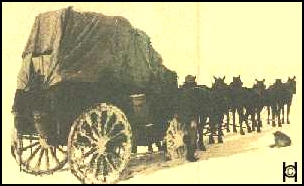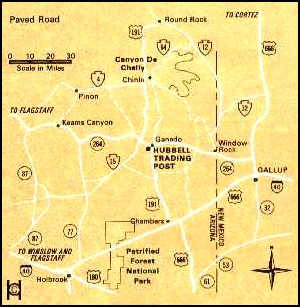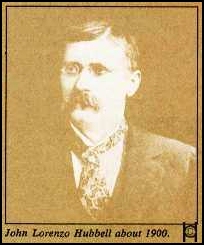
Hubbell Trading Post National Historic Site
|
Reservation trading posts were often the only direct point of contact between native and non-native Americans until well into the twentieth century. Much of the change in native lifeways came about through the agency of the reservation traders, and much of the early public awareness of the dignity and richness of the native cultures resulted from such daily trade. The Post Bridged Two Worlds
Hubbell Trading Post is typical of these stores. Inside its long, low stone walls is a rectangular iron stove, the center of the "bull pen." During winter it was always stocked with pinyon and juniper wood, and the Navajos, talking and laughing, lingered in the warmth. Behind the massive counters are shelves filled with coffee, flour, sugar, candy, Pendleton blankets, tobacco, calico, pocketknives, and canned goods. Hardware and harnesses hang from the ceiling. To the traders families, the posts were far removed from life among their own people. Some traders elected to leave their families in a nearby town, at least during school sessions, as Hubbell did early in his career, or tried to be self-sufficient in supplying needs not regularly available, as he did later. This post at Ganado included a blacksmith shop, a bakery, a farm, and, at times, a one-room school staffed by a teacher hired by Hubbell. The books and paintings provided the family with its own library and art gallery, and the opportunity to celebrate birthdays and holidays was never overlooked. Competition between traders was sometimes quite keen. They sponsored rodeos or chicken pulls and at times helped sponsor native ceremonies to attract customers to their area. Some traders would pay more for wool and other products made by Navajos who came from great distances. While their flour, coffee, and calico might be the least expensive brands, they spared no effort in attempting to handle the best in native goods such as buckskins and turquoise. There was little legal tender, so much of the business was carried on by exchange of Navajo products for the trader's goods or the use of trade tokens that each trading post had made according to its own specifications from brass, aluminum, or other metals. The trader was as dependent on the Navajo toleration of a stranger in their midst as the Indians were on a sympathetic white man when they needed to deal with the outside world. The trader had to learn their language, acquire some understanding of the social structure and economic resources of the community and respect their way of life. Failure to gain acceptance by the Navajo community might mean that his nearest competitor, perhaps a full day's travel away, would buy the wool and lambs that were the ultimate source for the trader's own credit with wholesale houses. At first, the Indians bought canned goods by the picture on the can, not by the brand name. Though traders wanted to cater to varied desires, they tried to limit the number of brands on their shelves to facilitate inventory control and to speed the trading operation. One trader is said to have taken a loss when he stocked cans of evaporated milk which had a picture of a flower on the label. The Indians, seeing the flower, would not believe that it contained real milk. The Hubbell rug room contains stacks of vari-colored blankets and rugs displaying the skill of Navajo women weavers. from the large beams across the ceilings hang baskets made by many southwestern tribes, saddles and saddle bags, bridles, and Indian water jugs. On the walls are small framed paintings of Navajo rugs by E.A. Burbank and other artists. Hubbell had these designs made as examples for the weavers. Today, Navajos still spend hours studying the silver earrings, bracelets, and necklaces in the jewelry case, for they appreciate the craftsmanship of their fellow artisans. Silver pieces with turquoise settings are their favorites. Besides introducing many new products to the Navajos, the traders functioned as vital intermediaries between the Navajos and the white community. The traders' support of Government programs-such as ones for education, livestock improvement, and modern medical care-was essential to their success. Some traders, such as Hubbell, helped Navajos obtain Government aid in building dams and irrigation projects. Traders' wives often taught them canning or how to use the sewing machine. The Hubbells not only hired many Navajos, but also recruited them for off-reservation jobs that were of educational as well as economic value. And, it was through the traders and their families that the Nation was able to gain much of its knowledge of Indian ways, for most early writers relied more upon the traders than on the Indians themselves for information. In recent years, social scientists who have made serious studies of Indian culture also have found the traders helpful. Nearly everyone of note who passed through northeast Arizona stopped at the Hubbell Trading Post: presidents, generals, writers, archaeologists and other scientists, and artists. Theodore Roosevelt, Nelson A. Miles, Lew Wallace, and Mary Roberts Rinehart were among the many distinguished visitors. Artist E.A. Burbank spent several months in the Hubbell home at various times; many of his paintings and drawings are displayed on the walls. The Hubbell home portrays vividly the Navajo and the Southwest. Bookcases overflow with rare and invaluable collections of Americana. Indian rugs lie everywhere. Priceless reminders of a courageous pioneer family, the era they helped to shape, and their remarkable customers and guests fill the rooms.
During this period, large-scale exploitation of oil, gas, and uranium deposits brought big business to the Navajo country. With it came additional income for the Navajos, resulting in the replacement of the horse and wagon by the pickup truck as basic transportation for most Navajo families. The supermarkets and department stores with their wide variety of goods are now within easy traveling distances. To compete with the modern conveniences of the chain stores, the trading posts, too, have become self-service. but Hubbell Trading Post, one of the oldest continuously operated trading posts on the Navajo Reservation, has changed little since its beginning a century ago. Business is still done in the traditional way. As it has since the days of their great-grandparents, the post serves as a bridge between cultures for many Navajos. John Lorenzo Hubbell
Hubbell was born in 1853 at Pajarito, New Mexico, the son of a Connecticut Yankee who had gone to New Mexico as a soldier and married into a family of Spanish descent. Mostly self-educated, he became familiar with the life, ways, and language of the Navajos while traveling about the Southwest as a young man and while serving as a clerk and as a Spanish interpreter. Hubbell - "Don Lorenzo" to the whites, "Old Mexican" or "Double Glasses" to the Navajos - began trading in Ganado in 1876. He bought out "Old Man" William Leonard 2 years later and settled at the present site. From the beginning, the Navajos flocked to the post, where Hubbell was not only their merchant but also their guide and teacher in understanding the ways of the white man. He was the trusted friend who translated and wrote letters, settled family quarrels, explained Government policy, and helped the sick. When a smallpox epidemic swept the reservation in 1886, he worked night and day caring for the sick and dying, using his own home as a hospital. He was immune because of a boyhood bout with the disease, but the Navajos ascribed it to a higher power. Hubbell had an enduring influence on Navajo rugweaving and silversmithing, for he consistently demanded and promoted excellence in craftsmanship. He built a trading empire that included stage and freight lines, as well as several trading posts. At various times, he and his two sons, together or separately, owned 24 trading posts, a wholesale house in Winslow, and other business and ranch properties. beyond question, he was the foremost Navajo trader of his time. Hubbell actively participated in politics. His career inspired novels and other literature, including a short story by Hamlin Garland about his service as sheriff of Apache County in the 1880's. He served in the Territorial Council, helped guide Arizona to statehood, was a State Senator, and ran unsuccessfully for the U.S. Senate. When he was first elected sheriff, Texas cattlemen invaded the sheep country of Apache County, Hubbell backed the sheepmen. Recollecting the bloody conflict he said, "I'd been shot at from ambush no less than a dozen times, and my home had been converted into a veritable fort. For one solid year not a member of my family went to bed except behind doors and windows barricaded with mattresses or sand bags." Though he had political inclinations, he was always primarily a businessman. One admirer wrote that "it was because he was just and honest and humane that he held this unquestioned supremacy" among traders with the Navajos. Hubbell expressed his business philosophy this way: "The first duty of an Indian trader, in my belief, is to look after the material welfare of his neighbors; to advise them to produce that which their natural inclinations and talent best adapts them; to treat them honestly and insist upon getting the same treatment from them...to find a market for their products and vigilantly watch that they keep improving in the production of same, and advise them which commands the best price. This does not mean that the trader should forget that he is to see that he makes a fair profit for himself, for whatever would injure him would naturally injure those with whom he comes in contact." Hubbell's career as a trader spanned critical years for the Navajos. He came to the reservation when they were grasping for an adjustment to reservation life, with the ordeal of the "Long Walk," including confinement at Fort Sumner, New Mexico, fresh in their minds. More than any other white man, he helped them find that adjustment. He was often their spokesman and contact with the outside world. Though a Roman Catholic, Hubbell persuaded the Presbyterian Board of Foreign Missions to choose nearby Ganado for a mission site and, while the mission was being built, took the first missionaries into his home for a year. On November 12, 1930, he passed away and was buried on Hubbell Hill, overlooking the trading post, next to his wife, Lina Rubi, and his closest Navajo friend, Many Horses. One old man expressed the sadness of his fellow Navajos when he said: "You wear out your shoes, you buy another pair;
How to get there!!!! Hubbell Trading Post is on the Navajo Indian Reservation, 1 mile west of Ganado and 55 miles northwest of Gallup New Mexico. It can be reached by Arizona 264 (Navajo Route 3) from the east and west and by Arizona 63 from the north and south. You will find Hubbell Trading Post on the way to Grand Canyon National Park, Canyon de Chelly National Monument, and the Hopi Mesas. Administration Hubbell Trading Post National Historic Site is open daily from 8 a.m. to 5 p.m. (8 a.m. to 6 p.m. in summer) except Thanksgiving, December 25, and January 1. It is administered by the National Park Service U.S. Department of the Interior. Groups may obtain special service by making advance arrangements with the superintendent, whose address in Box 150, Ganado, AZ 86505. Information courtesy National Park Service, U.S. Department of the Interior.Petrified Forest National Park Prehistoric Man In the Petrified Forest Navajo County Parks |
 To the
Navajos the trading post was a place of social life as well as business. To
reach the post they traveled long miles by horse and wagon or by foot over
trails which were usually dry and dusty but in wet weather slick with mud. The
post was a place to sell their colorful handwoven rugs and beautiful turquoise
and silver jewelry - but it was also a gathering place to meet old friends and
relatives. Trading was a slow process and no effort was made to hurry it. The
store was a center for news, gossip, and endless talk.
To the
Navajos the trading post was a place of social life as well as business. To
reach the post they traveled long miles by horse and wagon or by foot over
trails which were usually dry and dusty but in wet weather slick with mud. The
post was a place to sell their colorful handwoven rugs and beautiful turquoise
and silver jewelry - but it was also a gathering place to meet old friends and
relatives. Trading was a slow process and no effort was made to hurry it. The
store was a center for news, gossip, and endless talk.  Shortly after World
War II, trading posts on the Navajo Reservation began to decline. The impact of
changing times had lessened the Indian's dependence on the reservation trader.
Many Navajos had served in the military forces and had returned from the war
with a greater knowledge of the outside world.
Shortly after World
War II, trading posts on the Navajo Reservation began to decline. The impact of
changing times had lessened the Indian's dependence on the reservation trader.
Many Navajos had served in the military forces and had returned from the war
with a greater knowledge of the outside world.  The dean of the traders to the Navajo was John Lorenzo
Hubbell. During a half century on the reservation he was known for his honesty
in business dealings, for his hospitality to travelers, and for his wise
counsel to his friends the Navajos.
The dean of the traders to the Navajo was John Lorenzo
Hubbell. During a half century on the reservation he was known for his honesty
in business dealings, for his hospitality to travelers, and for his wise
counsel to his friends the Navajos.